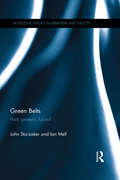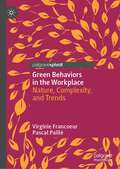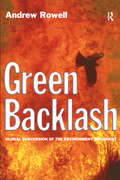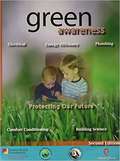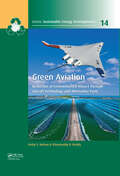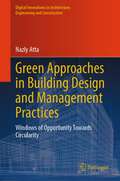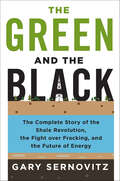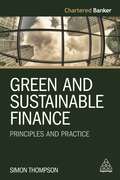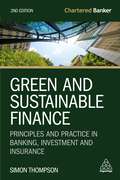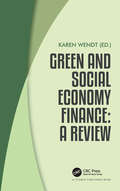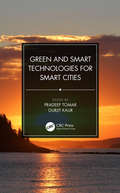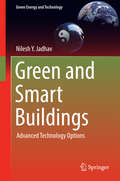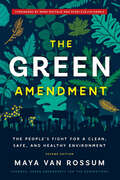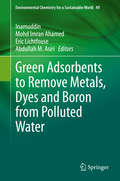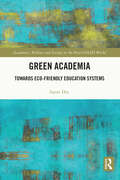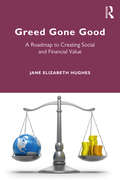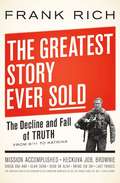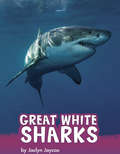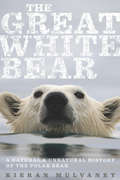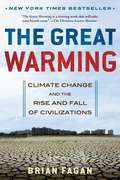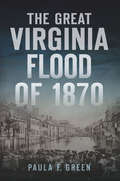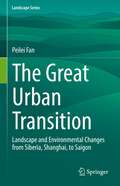- Table View
- List View
The Green Book: The Everyday Guide to Saving the Planet One Simple Step at a Time
by Elizabeth Rogers Thomas M. KostigenWater is the biggest environmental issue facing us today. It's a resource we can't live without, yet most of us take it for granted as we brush, flush, and consume water seemingly without limit. We hose our driveways and over water our lawns. But all of that is about to change; we're quickly running out of our freshwater supply.
Green Black Red: Recipes for Cooking and Enjoying California Grapes
by Susan VollandGreen, black, or red, grapes have long been the stars of the snack bowl and the wine press. Now, the versatility of the grape is explored as a key ingredient in 60 recipes for every occasion.
Green Belts: Past; present; future? (Routledge Studies in Urbanism and the City)
by John Sturzaker Ian MellMost of us have heard of green belts – but how much do we really know about them? This book tries to separate the fact from the fiction when it comes to green belts by looking both backwards and forwards. They were introduced in the mid-twentieth century to try and stop cities merging together as they grew. There is little doubt they have been very effective at doing that, but at what cost? Are green belts still the answer to today’s problems of an increasing population and ever higher demands on our natural resources? Green Belts: Past; present; future? reflects upon green belts in the United Kingdom at a time when they have perhaps never been more valued by the public or under more pressure from development. The book begins with a historical study of the development of green belt ideas, policy and practice from the nineteenth century to the present. It discusses the impacts and characteristics of green belts and attempts to reconcile perceptions and reality. By observing examples of green belts and similar policies in other parts of the world, the authors ask what we want green belts to achieve and suggest alternative ways in which that could be done, before looking forward to consider how things might change in the coming years. This book draws together information from a range of sources to present, for the first time, a comprehensive study of green belts in the UK. It reflects upon the gap between perception and reality about green belts, analyses their impacts on rural and urban areas, and questions why they retain such popular support and whether they are still the right solution for the UK and elsewhere. It will be of interest to anyone who is concerned with planning and development and how we can provide the homes, jobs and services we need while protecting our more valuable natural assets.
Green Behaviors in the Workplace: Nature, Complexity, and Trends
by Virginie Francoeur Pascal PailléThis book examines the spectrum of green behaviors in organizational settings, focusing on the contribution that employees make through their environmental engagement. The authors provide an overview of green behaviors while clarifying the meaning of the concept and its critical importance to greening employees. By distinguishing between voluntary (e.g., encouraging colleagues to express their ideas about environmental issues), prescribed (e.g., having an obligation to implement environmental policies), and counterproductive (e.g., not caring about water or electricity consumption) behaviors, the book rethinks sustainable development, placing the psychological and environmental dimensions on a par.Aimed at researchers in human resource management, organizational behavior, organizational change, and psychology, this interdisciplinary study proposes a novel approach to sustainability by assessing employee behaviors at work.
Green Backlash: Global Subversion of the Environment Movement
by Andrew RowellThe tide is turning against environmentalism as the political right, industry and governments fight back. Green Backlash is a controversial expose of the anti-environmental movement. Tracing the rise of the backlash from the Wise Use movement in the USA, the author reveals its rapid spread worldwide: the anti-roads movement in the UK, forestry debates in Canada and Australia, marine resource issues in Europe, South-East Asia, and controversies such as the Brent Spar. The backlash is set to get worse as the resource wars intensify. This book offers a greater understanding of the challenges and threats facing global environmentalism, concluding that the environmental movement now has a chance to re-evaluate and change for the better to beat the backlash - a chance that must not be missed.
Green Awareness (Second Edition)
by Esco PressThe Green Awareness training program provides a basic understanding of green concepts, terminology, systems, and the latest in green mechanical technology. This Second Edition manual has been revised and updated and now contains five sections: Energy Analysis and Awareness, Building Science, HVACR, Electrical and Plumbing.
Green Aviation: Reduction of Environmental Impact Through Aircraft Technology and Alternative Fuels (Sustainable Energy Developments)
by Emily S. Nelson D. R. ReddyAircraft emissions currently account for ~3.5% of all greenhouse gas emissions. The number of passenger miles has increased by 5% annually despite 9/11, two wars and gloomy economic conditions. Since aircraft have no viable alternative to the internal combustion engine, improvements in aircraft efficiency and alternative fuel development become essential. This book comprehensively covers the relevant issues in green aviation. <P><P>Environmental impacts, technology advances, public policy and economics are intricately linked to the pace of development that will be realized in the coming decades. Experts from NASA, industry and academia review current technology development in green aviation that will carry the industry through 2025 and beyond. This includes increased efficiency through better propulsion systems, reduced drag airframes, advanced materials and operational changes. <P><P>Clean combustion and emission control of noise, exhaust gases and particulates are also addressed through combustor design and the use of alternative fuels. Economic imperatives from aircraft lifetime and maintenance logistics dictate the drive for "drop-in" fuels, blending jet-grade and biofuel. New certification standards for alternative fuels are outlined. Life Cycle Assessments are used to evaluate worldwide biofuel approaches, highlighting that there is no single rational approach for sustainable buildup. In fact, unless local conditions are considered, the use of biofuels can create a net increase in environmental impact as a result of biofuel manufacturing processes. Governmental experts evaluate current and future regulations and their impact on green aviation. Sustainable approaches to biofuel development are discussed for locations around the globe, including the US, EU, Brazil, China and India.
Green Approaches in Building Design and Management Practices: Windows of Opportunity Towards Circularity (Digital Innovations in Architecture, Engineering and Construction)
by Nazly AttaThis book examines green transition and circular economy in the fields of building design and Real Estate management. By outlining windows for seizing the opportunity to integrate circular approaches in current building practices, the book provides information tools to support building stakeholders (e.g. building designer and managers, manufacturers, Real Estate owners, maintenance operators, facility managers, etc.) in: (i) understanding circular re-strategies (e.g. reuse, remanufacturing, repurposing, etc.), the related requirements and the pre-conditions for their implementation within building design and management practices; (ii) reviewing design approaches at the product and building scale, also highlighting new circularity-related contents for the Briefing Documents; (iii) developing circular organizational and contract models for the procurement of Facility Management services, also integrating new circularity-related contents in Invitations to Tenders (ITTs); and (iv) assessing the quality and the effectiveness of circular practices, also highlighting circularity performance metrics and indicators in the context of corporate sustainability reporting.
The Green and the Black: The Complete Story of the Shale Revolution, the Fight over Fracking, and the Future of Energy
by Gary SernovitzGary Sernovitz leads a double life. A typical New York liberal, he is also an oilman - a fact his left-leaning friends let slide until the word "fracking" entered popular parlance. "How can you frack?" they suddenly demanded, aghast. But for Sernovitz, the real question is, "What happens if we don't?"Fracking has become a four-letter word to environmentalists. But most people don't know what it means. In his fast-paced, funny, and lively book, Sernovitz explains the reality of fracking: what it is, how it can be made safer, and how the oil business works. He also tells the bigger story. Fracking was just one part of a shale revolution that shocked our assumptions about fueling America's future. The revolution has transformed the world with consequences for the oil industry, investors, environmentalists, political leaders, and anyone who lives in areas shaped by the shales, uses fossil fuels, or cares about the climate - in short, everyone. Thanks to American engineers' oilfield innovations, the United States is leading the world in reducing carbon emissions, has sparked a potential manufacturing renaissance, and may soon eliminate its dependence on foreign energy. Once again the largest oil and gas producer in the world, America has altered its balance of power with Russia and the Middle East.Yet the shale revolution has also caused local disruptions and pollution. It has prolonged the world's use of fossil fuels. Is there any way to reconcile the costs with the benefits of fracking?To do so, we must start by understanding fracking and the shale revolution in their totality. The Green and the Black bridges the gap in America's energy education. With an insider's firsthand knowledge and unprecedented clarity, Sernovitz introduces readers to the shales - a history-upturning "Internet of oil" - tells the stories of the shale revolution's essential characters, and addresses all the central controversies. To capture the economic, political, and environmental prizes, we need to adopt a balanced, informed perspective. We need to take the green with the black. Where we go from there is up to us.
Green and Sustainable Finance: Principles and Practice (Chartered Banker Series #6)
by Simon ThompsonMore than 120 countries have committed to net zero targets by 2050, requiring systemic economic transitions on an unprecedented scale and with the finance sector playing a leading role. Green finance will power the transition, ensuring capital flows to the firms, investments, projects and technologies looking to create a sustainable, low-carbon world. To achieve net zero, every professional financial decision must take climate change and broader sustainability factors into account. Green and Sustainable Finance provides a comprehensive guide to the application of common green and sustainable principles and practices in banking, investment and insurance to help finance professionals embed these in their daily activities and decision-making. Focusing on the necessity of mainstreaming green and sustainable finance globally, this book includes a clear explanation of the science underpinning climate change. Green and Sustainable Finance covers a wide range of green finance products and services in retail, commercial and corporate banking, insurance, investment and fintech. It provides an overview of emerging regulation and international market frameworks and standards, particularly in relation to climate and environmental risk. Consideration is also given to the ethical dimensions of green and sustainable finance, including how professionals can promote market integrity and take active steps to avoid greenwashing. Endorsed by the Chartered Banker Institute as the core text for the benchmark Certificate in Green and Sustainable Finance, this book is essential reading for finance professionals and students, and individuals working to embed sustainability in business, policy and regulation.
Green and Sustainable Finance: Principles and Practice in Banking, Investment and Insurance (Chartered Banker Series #7)
by Simon ThompsonTo achieve society's goals, as set out in the UN Sustainable Development Goals and the Paris Agreement, the finance sector has a crucial role to play in driving sustainable business and the transition to a net zero economy.To achieve this change, it is vital for the finance sector to allocate capital to the firms, investments and activities looking to create a more sustainable world. Green and Sustainable Finance offers a comprehensive guide to green and sustainable principles and practice in banking, investment and insurance to help finance professionals manage sustainability risks and support their clients and customers in transition. Given the need for urgent, rapid and sustained change, it is essential that all finance professionals understand and apply these principles so that every professional financial decision takes account of sustainability.Written by the CEO of the Chartered Banker Institute this fully updated second edition includes the most recent assessments of climate science from the IPCC, extended coverage of sustainability reporting and carbon accounting, and regulatory and market developments in sustainability risk management. It also features material on the rapid growth of sustainable lending and investment and the latest finance sector alliances and initiatives. Endorsed by the Chartered Banker Institute as the core text for the global benchmark Certificate in Green and Sustainable Finance, this book is essential reading for finance professionals, university students and individuals working to embed sustainability in business, finance, policy and regulation.
Green and Social Economy Finance: A Review
by Karen WendtGreen and Social Economy Finance is a compilation of chapters by experts, linking research and practice. This anthology provides a new thinking on social economy green finance, showing emerging themes and trends. It spans from stock markets, green finance, innovations, digitalization to social finance, governance and theories of change. It concentrates on impact, opportunity recognition and development of financial products designed to finance the green and social economy. Without the attraction of capital, social entrepreneurship, and innovations, green finance can face difficulty in addressing business solutions. Green and social economy is a nascent field. The authors address the conceptualization of green and social solutions and identify new trends in the finance industry products and approaches. The book demonstrates that aligning finance and investment with the Paris Agreement, sustainable development goals and needs and interests of society are feasible.
Green and Smart Technologies for Smart Cities
by Pradeep Tomar Gurjit KaurThe book starts with an overview of the role of cities in climate change and environmental pollution worldwide, followed by the concept description of smart cities and their expected features, focusing on green technology innovation. This book explores the energy management strategies required to minimize the need for huge investments in high-capacity transmission lines from distant power plants. A new range of renewable energy technologies modified for installation in cities like small wind turbines, micro-CHP and heat pumps are described. The overall objective of this book is to explore all the green and smart technologies for designing green smart cities.
Green and Smart Buildings
by Nilesh Y. JadhavThis book highlights the various technologies that are currently available or are now being developed for the green and smart buildings of the future. It examines why green building performance is important, and how it can be measured and rated using appropriate benchmarking systems. Lastly, the book provides an overview of the state-of-the-art in green building technologies and the trend towards zero energy or net positive energy buildings in the future.
The Green Amendment: The People's Fight for a Clean, Safe, and Healthy Environment
by Maya K. van RossumA veteran environmentalist shares her roadmap to a healthier world—one that uses the law to empower activists and provide hope for communities everywhere.We have reached a critical tipping point in our fight for the environment: Corporations profit off climate change, natural disasters devastate homes, and the most vulnerable suffer the health effects of pollution. Yet our laws are designed to accommodate this destruction rather than prevent it. Without government support, it's no wonder people feel powerless.But there is a solution. In The Green Amendment, veteran environmentalist Maya K. van Rossum presents her radically simple plan for a green future: bypass local laws and turn to the ultimate authority—our state and federal constitutions—to ensure we have the right to a healthy environment.Through compelling interviews with activists on the ground, clear evidence from experts, and heartbreaking stories from those hit hardest by environmental ruin, The Green Amendment lights the path forward. In this updated edition of her trailblazing 2017 book, van Rossum invites readers to join the movement by sharing:Why Green Amendments work where other movements have failedHow to position Green Amendments and what specific language offers the strongest legal protectionsHow to argue in favor of environmental rights, and the economic and health benefits that will help activists make the caseHow Green Amendments address the crucial intersection of environmentalism and anti-racismWhat everyone—from artists and students to scientists and lawyer—can do to further the causeWith the power of The Green Amendment, we can claim our environmental rights, ensuring a clean, safe Earth for generations to come.
Green Adsorbents to Remove Metals, Dyes and Boron from Polluted Water (Environmental Chemistry for a Sustainable World #49)
by Inamuddin Mohd Imran Ahamed Eric Lichtfouse Abdullah M. AsiriThis book reviews adsorption techniques to clean wastewater, with focus on pollution by dyes and heavy metals. Advanced adsorbents include carbon nanomaterials, biomass, cellulose, polymers, clay, composites and chelating materials.
Green Academia: Towards Eco-Friendly Education Systems (Academics, Politics and Society in the Post-Covid World)
by Sayan DeyThis book studies the importance of adopting Green Academia as a systemic long-term counter-intervention strategy against any form of impending pandemics in the post-COVID era and beyond. It argues that anti-nature and capitalistic knowledge systems have contributed to the evolution and growth of COVID-19 across the globe and emphasizes the merits of reinstating nature-based and environment-friendly pedagogical and curricular infrastructures in mainstream educational institutions. The volume also explores possible ways of weaving ecology and the environment as a habitual practice of teaching and learning in an intersectional manner with Science and Technology Studies. With detailed case studies of the green schools in Bhutan and similar practices in India, Kenya, and New Zealand, the book argues for different forms of eco-friendly education systems and the possibilities of expanding these local practices to a global stage. Part of the Academics, Politics and Society in the Post-COVID World series, this book will be an essential read for scholars and researchers of sociology, cultural studies, decolonial studies, education, ecology, public policy social anthropology, sustainable development, sociology of education, and political sociology.
Greed Gone Good: A Roadmap to Creating Social and Financial Value
by Jane Elizabeth HughesGreed Gone Good: A Roadmap to Creating Social and Financial Value brings the how-tos of impact finance to a broad- based audience of investors, from the individual to the institutional. Written in an engaging, jargon-free style and loaded with practical advice, it explores the pitfalls and potential of the burgeoning impact revolution—the increasingly widespread belief that business and financial leaders should weigh social value as well as financial value in all of their decisions, to create both a better business model and a better world. Cheerleaders have written a number of books advocating the magic of impact finance. Greed Gone Good hopes for the magic too, but also believes that an uncritical eye does not effectively advance the cause. We now have 10 years of impact investing history to examine, and not all of it is laudable. We could hold hands and sing Kumbaya in praise of impact finance; or we could employ constructive criticism to figure out what’s gone well and what hasn’t, and how we should move forward more productively. Greed Gone Good focuses on the roadmap—how to reorient and repackage finance and investing in order to deliver on this promise. In particular, it focuses on how to realize the potential of the impact revolution to become a silver bullet against future failures. Green Gone Good will have widespread appeal to investors ranging from individuals and family offices to the world’s largest asset managers and investors.
The Greatest Story Ever Sold: The Decline and Fall of Truth From 9/11 to Katrina
by Frank RichA step-by-step account of how skillfully the White House has built its house of cards, to consolidate its power at any cost.
Great White Sharks (Animals)
by Jaclyn JaycoxGreat white sharks are the largest predatory sharks in the sea! They live all over the world, have many sharp teeth, and can smell blood from miles away. Dive deep into the ocean, and find all the facts about these incredible sharks.
The Great White Shark Scientist (Scientists in the Field Series)
by Sy Montgomery Keith Ellenbogen<P>Dr. Greg Skomal, biologist and head of the Massachusetts Shark Research Program, is investigating a controversial possibility: Might Cape Cod's waters serve as a breeding ground for the great white shark, the largest and most feared predatory fish on Earth? <P>Sy Montgomery and Keith Ellenbogen report on this thrilling turning point in marine research and travel to Guadeloupe, Mexico, to get up close and personal with the sharks. This daring expedition into the realm of great whites shows readers that in order to save the planet and its creatures, we must embrace our humanity and face our greatest fears. <P><b>Winner of the 2018 Riverby Award</b>
The Great White Bear: A Natural and Unnatural History of the Polar Bear
by Kieran MulvaneyPolar bears are creatures of paradox: They are white bears whose skin is black; massive predators who can walk almost silently; Arctic residents whose major problem is not staying warm, but keeping cool. Fully grown they can measure 10 feet and weigh close to 2,000 pounds, but at birth they are just 20 ounces. Creatures that may wander thousands of miles over the course of a year, they begin life in a snowdrift. Human encounters with these legendary beasts are cause for both excitement and apprehension. Tales throughout history describe the ferocity of polar bear attacks on humans; but human hunting of polar bears has exacted a far larger toll, obliging Arctic nations to try to protect their region's iconic species before it's too late. Now, however, another threat to the polar bears' survival has emerged, one that is steadily removing sea ice and the life it supports. Without this habitat, polar bears cannot exist. The Great White Bear celebrates the story of this unique species. Through a blend of history, both natural and human, through myth and reality and observations both personal and scientific, Kieran Mulvaney masterfully provides a context for readers to consider the polar bear, its history, its life, and its uncertain fate.
The Great Warming: Climate Change and the Rise and Fall of Civilizations
by Brian M. FaganA breakout bestseller on how the earth's previous global warming phase reshaped human societies from the Arctic to the Sahara--a wide-ranging history with sobering lessons for our own time. From the tenth to the fifteenth century the earth experienced a rise in surface temperature that changed climate worldwide--a preview of today's global warming. In some areas, including western Europe, longer summers brought bountiful harvests and population growth that led to cultural flowering. In the Arctic, Inuit and Norse sailors made cultural connections across thousands of miles as they traded precious iron goods. Polynesian sailors, riding new wind patterns, were able to settle the remotest islands on earth. But in many parts of the world, the warm centuries brought drought and famine. Elaborate societies in western and central America collapsed, and the vast building complexes of Chaco Canyon and the Mayan Yucatán were left empty. The history of the Great Warming of a half millennium ago suggests that we may yet be underestimating the power of climate change to disrupt our lives today--and our vulnerability to drought, writes Fagan, is the "silent elephant in the room. "
The Great Virginia Flood of 1870 (Disaster)
by Paula F. GreenIn the fall of 1870, a massive flood engulfed parts of Virginia, West Virginia and Maryland. What began near Charlottesville as welcome rain at the end of a drought-plagued summer quickly turned into a downpour as it moved west and then north through the Shenandoah Valley. The James, Shenandoah and Potomac Rivers rose, and flooding washed out fields, farms and entire towns. The impact was immense in terms of destruction, casualties and depth of water. The only warning that Richmond, downriver from the worst of the storm, had of the wall of water bearing down on it was a telegram. In this account, public historian Paula Green details not only the flood but also the process of recovery in an era before modern relief programs.
The Great Urban Transition: Landscape and Environmental Changes from Siberia, Shanghai, to Saigon (Landscape Series #34)
by Peilei FanThis monograph examines the (sub)urbanization process of seven transitional economies in Southeast, East, and North Asia (SENA), i.e., Siberia of Russia in North Asia, China and Mongolia in East Asia, and Cambodia, Lao PDR, Myanmar, and Vietnam in Southeast Asia. In ten chapters, great urban transformation occurred in SENA is discussed, as well as the transitional period which aggravated urban environments in SENA cities and how ‘institutional shift,’ enabled by movements of urban residents and transitional urban governance, may facilitate the process and improve the urban environmental condition. This book includes land cover and land use data derived from satellite images over the past thirty years and intensive field research in more than thirty cities exploring the rise of these great cities and their environmental challenges. Unlike in western countries, the current urbanization process in Asian transitional economies is a hybrid product of market logic and state legacy and intervention, with these influences sometimes conflicting and at other times enhancing each other, under intensified globalization. This book is of interest to researchers and students interested in landscape, urban studies, environment studies in particularly Asia, as well as planners and policy makers.


